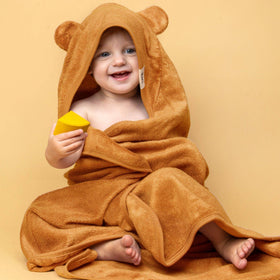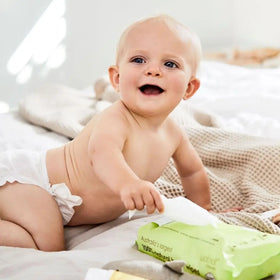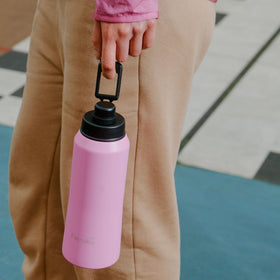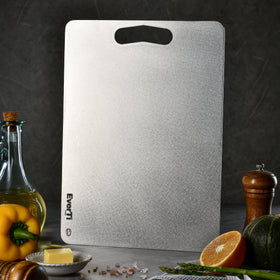
Toxic Ingredients in Baby Wipes: What to Avoid for Your Baby's Safety
We've been examining many baby wet wipes recently as we update our Baby Wipes Cheat Sheet. Although baby wipe manufacturers have cleaned up their ingredients in recent years, we're not there yet. There are still harmful ingredients in baby wipes, especially when used around super sensitive areas like bottoms and mouths, which can affect a baby's delicate skin. Toxic chemicals in these wet baby wipes can cause irritations and other health issues for your baby. What makes us cross is that big brands keep the truth from us.
Indeed, in some cases, it's outright lies. Don't read the front of the pack, where it's all marketing talk and meaningless words like 'hypoallergenic' and 'dermatologist tested'. Read the back of the pack and the ingredients list. That's where the truth lies! When you're reading the pack, here's our list of non toxic baby wipes ingredients to avoid. If you see them, put the pack down and walk away. And to make life even easier, why not download a free copy of our Baby Wipes Cheat Sheet ebook?

What are Most Baby Wipes Made of?
What are wipes made of? There's the cloth of the actual wipe, and there's the cleansing solution. The baby wipes material is usually called 'non-woven' fibre, plastic threads so thin they can be spun to make cloth. You can also find biodegradable baby wipes, which are often made of bamboo but can be made of other types of plant based rayon, too.
What are the usual baby wipe ingredients? Generally, you'll find the following disposable baby wipes with:
- Water (or sometimes aloe vera) as the base of the solution
- Detergents (surfactants) to help remove the dirt
- Moisturising agents or humectants (like propylene glycol and glycerine)
- Fragrances that provide a pleasant scent and mask any unpleasant odours
- Preservatives to stop bacteria and mould from growing, as wipes are primarily composed of water.
The formulation of the baby wipes solution aims to be gentle yet effective, combining soothing moisturisers, protective preservatives, and fragrance ingredients. It's all about maintaining hygiene while caring for delicate baby skin, ensuring each wipe is safe and comfortable. However, not all baby wipes ingredients are created equal. Let's now delve into specific toxic ingredients to avoid, prioritising the safety and well-being of your little one.

What Ingredients To Avoid in Baby Wipes? Only The Toxic Ones!
What's in baby wipes? When checking the ingredients in baby wipes, it's important to be aware that many of the products on store shelves contain potentially harmful chemicals. Be sure to read the packaging and avoid wipes containing these toxic ingredients.
Bronopol
Bronopol, a preservative also known as 2-Bromo-2-nitro-1,3-propanediol, is a formaldehyde donor like DMDM hydantoin. It releases formaldehyde as it breaks down, and the EWG has given it a big red number, indicating a high level of concern. This known irritant is an ingredient that really shouldn't be used in baby products due to the potential for skin irritation.

DMDM hydantoin
DMDM hydantoin is another preservative. The problem with it is that it's a formaldehyde donor, so it releases formaldehyde as it breaks down. The EWG has a big red flag on this one. It's also an irritant, so that's another reason to keep it away from your baby.
Fragrance or Perfume
The problem with fragrance is that you don't know what's in it. Manufacturers don't have to disclose fragrance ingredients, so you could be putting phthalates, neurotoxins, endocrine disrupters, allergens or irritants onto your baby's skin.

Parabens
Parabens are common preservatives that are bad ingredients in baby wipes, shampoos, and other baby skincare products. They are also found in shaving creams, hair care products, moisturisers, and deodorants. There are many of them, but the common ones are butyl, ethyl, methyl, and propyl (and they all end in paraben). Their main problem is that they are suspected endocrine disrupters and may interfere with the body’s hormones.
PEGs (polyethylene glycols)
PEGs are a penetration enhancer, so they help other baby wipe ingredients penetrate more deeply into the skin. They can be contaminated with ethylene oxide and 1,4-dioxane. They also should not be used on damaged skin (which means nappy rash or diaper rash).
Phenoxyethanol
Manufacturers are increasingly using phenoxyethanol in baby wipes as they steer clear of parabens. However, it's important to note that it's an irritant and should not be used around the mouth. More importantly, according to the FDA, it can depress the central nervous system in infants, making it unsuitable for use in babies. This information should make parents more cautious about the products they choose for their children.

Phthalates
These days, phthalates are rarely used as an individual ingredient in baby products but may be found in perfumes or fragrances. That's why you should always avoid scented baby products unless the scent in unscented baby wipes is made from essential oils. Phthalates are a concern because they're thought to be endocrine disrupters, changing how hormones work in the body.
Propylene Glycol
Propylene glycol, a humectant, is quite common in baby wipes. However, while it's not toxic, it's an irritant and a penetration enhancer. That means it helps other ingredients penetrate more deeply into the skin, which is not always ideal.
It's becoming easier to find baby wipes without propylene glycol, but read the back of the pack - don't assume! Checking labels ensures you understand the ingredients in baby wipes, helping you avoid harmful chemicals in baby wipes like propylene glycol, which can impact the baby's sensitive skin.

Methylisothiazolinone (MIT)
Another common preservative is methylisothiazolinone, although it's less widely used in baby wipes after media coverage in the last few years. Methylisothiazolinone in baby wipes has been widely associated with contact dermatitis.
It's no longer being used in big brands like Huggies, though. Huggies baby wipes have stopped using Methylisothiazolinone (MIT) due to concerns about skin irritation and allergies linked to this ingredient. This change reflects broader industry practices to improve product safety, avoiding harmful chemicals like MIT. It's listed in Kimberly-Clark's Restricted Chemicals List, underlining the industry's commitment to high safety standards and ingredient scrutiny.
We've listed other preservatives to avoid in this post, along with the good preservatives.
Sodium Lauryl Sulphate (SLS) and Sodium Laureth Sulphate (SLES)
Sodium lauryl sulphate (SLS) and sodium laureth sulphate (SLES) are commonly used detergents in water based baby wipes, valued for their cleaning effectiveness. However, these sulphates are known irritants that can cause skin irritation and allergic reactions, particularly on delicate baby skin.
Concerns also exist about their potential long-term effects on organ toxicity. Opting for baby wipes formulated with gentler, natural detergents like coco-glucoside or decyl glucoside derived from coconut or corn sugars can provide a safer option. These alternatives, known for their exceptional gentleness, are milder on the skin, biodegradable, and derived from plant sources, giving parents and caregivers confidence in their choice.
Triclosan
Triclosan is a chemical found in antibacterial baby wipes, which we've written more about it here. It's another suspected endocrine disrupter and is contributing to the rise in antibiotic-resistant bacteria. Triclosan isn't often found in baby wipes, but it's worth noting that antibacterial wipes shouldn't be used for nappy changes, even in an emergency!

Alcohol
A reasonably common question we get asked is, "Do baby wipes have alcohol in them?" The answer is 'no,' as alcohol is too harsh and too drying on the skin.
Instead of alcohol, look for alcohol free baby wipes formulated with soothing ingredients like aloe vera or chamomile extract. These alternatives not only help maintain skin moisture and protect against dryness but also provide a gentler and more comfortable cleaning experience for your baby's sensitive skin. This should give you the confidence that you're choosing the best for your little one.
Protecting Your Baby's Well-Being with Safe Eco Baby Wipes
Now that you're informed about the potentially toxic ingredients in baby wipes, you're in a position to make confident and responsible choices for your little one's well-being. By prioritising your baby's delicate skin and overall health, you're taking control. Opt for natural baby wipes free from harmful chemicals like parabens, phthalates, and synthetic fragrances and choose natural alternatives wherever possible.
So, which are the safest baby wipes? Confused? Don't be! Download a copy of our Baby Wipes Cheat Sheet, and you'll know exactly which non-toxic baby wipes to look for! So now that you know about these wet wipes ingredients, you can do your best to avoid them. Ensure every wipe is a gentle, safe choice for your baby's comfort and care.











